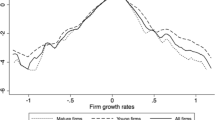Abstract
This paper looks at the probability of introducing innovations by manufacturing firms at different stages of their lives. Once differences related to activity and size are controlled for, we examine how the probability of innovation varies over entry, post-entry ages, and advanced ages of mature firms. We also measure the association between exit from the market and pre-exit innovation. Results show that the probability of innovating widely varies by activity, and that small size per se broadly reduces the probability of innovation, but also that entrant firms tend to present the highest probability of innovation while the oldest firms tend to show lower innovative probabilities. Some sets of firms with intermediate ages also present a high probability of innovation, and exiting firms are clearly associated to lower levels of introducing process innovations.
Similar content being viewed by others
References
Acs, Z. and D. Audretsch, 1988, ‘Innovation in Large and Small Firms: An Empirical Analysis’, American Economic Review 78, 678-690.
Acs, Z. and D. Audretsch, 1990, Innovation and Small Firms, MIT Press.
Agarwal, R., 1998, ‘Small Firm Survival and Technological Activity’, Small Business Economics 11, 215-224.
Audretsch, D., 1995a, Innovation and Industry Evolution, MIT Press.
Audretsch, D., 1995b, ‘Innovation, Growth and Survival’, International Journal of Industrial Organization 13, 441-447.
Cohen, W. M. and S. Klepper, 1996, ‘Firm Size and the Nature of Innovation within Industries: The Case of Process and Product R&;D”’, Review of Economics and Statistics 78, 232-243.
Doms, M., T. Dunne and M. Roberts, 1995, ‘The Role of Technology Use in the Survival and Growth of Manufacturing Plants’, International Journal of Industrial Organization 13, 523-542.
Geroski, P., 1995, ‘What Do We Know About Entry?’, International Journal of Industrial Organization 13, 421-440.
Hansen, J. A., 1992, ‘Innovation, Firm Size, and Firm Age’, Small Business Economics 4, 37-44.
Huergo, E. and J. Jaumandreu, 2002, ‘Firms' Age, Process Innovation and Productivity Growth’, mimeo.
Klepper, S., 1996, ‘Entry, Exit and Innovation Over the Product Life Cycle’, American Economic Review 86, 562-583.
McGahan, A. M. and B. S. Silverman, 2001, ‘How Does Innovative Activity Change as Industries Mature?’, International Journal of Industrial Organization 19, 1141-1160.
Robinson, P. M., 1988, ‘Root-n Consistent Semiparametric Regression’, Econometrica 56, 97-118.
Speckman, P., 1988, ‘Kernel Smoothing in Partially Linear Models’, Journal of the Royal Statistical Society, Series B 50, 413-446.
Suits, D., 1984, ‘Dummy Variables: Mechanics vs. Interpretation’, Review of Economics and Statistics 66, 177-180
Wand, M. P. and M. C. Jones, 1995, Kernel Smoothing, Chapman &; Hall.
Author information
Authors and Affiliations
Rights and permissions
About this article
Cite this article
Huergo, E., Jaumandreu, J. How Does Probability of Innovation Change with Firm Age?. Small Business Economics 22, 193–207 (2004). https://doi.org/10.1023/B:SBEJ.0000022220.07366.b5
Issue Date:
DOI: https://doi.org/10.1023/B:SBEJ.0000022220.07366.b5



